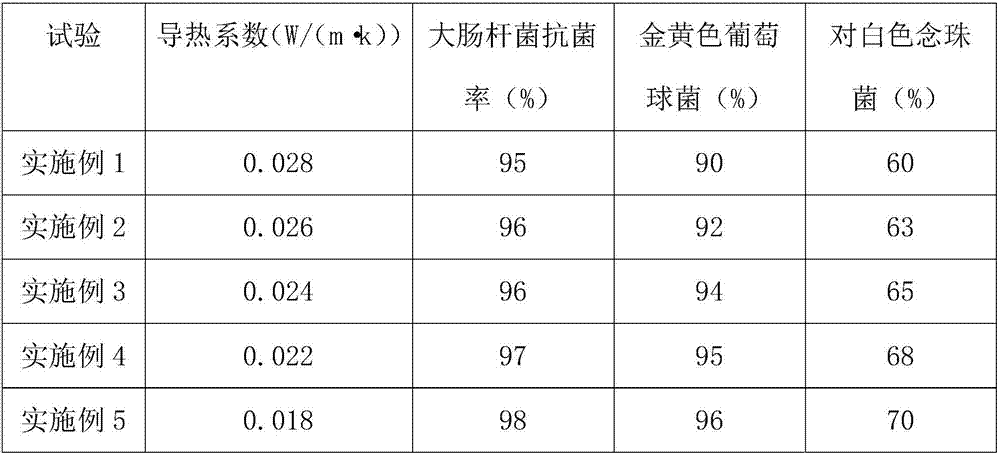Antibacterial type rubber-plastic foaming thermal insulation material and preparation method thereof
A technology of thermal insulation materials and rubber-plastic foaming, which is applied in the field of foam thermal insulation materials, can solve the problems of high comprehensive cost, cracking of surface mortar, low thermal conductivity, etc. Effect
- Summary
- Abstract
- Description
- Claims
- Application Information
AI Technical Summary
Problems solved by technology
Method used
Image
Examples
Embodiment 1
[0021] (1) 15 parts of chloroprene rubber, 25 parts of nitrile rubber and 30 parts of binary ethylene-propylene rubber are banburyed to a molten state at a temperature of 60 ° C and a rotating speed of 30 rpm;
[0022] (2) Add 10 parts of phenolic resin, 15 parts of 4-aminophenethyl alcohol, 8 parts of stearic acid and 3 parts of tributyl citrate to step (1), and knead at a temperature of 90°C and a speed of 60 rpm for 10 minutes;
[0023] (3) When the temperature in step (2) drops to 60°C, add 2 parts of carbohydrazide, 1 part of calcium carbonate and 2 parts of n-hexane, then raise the temperature to 100°C at a rate of 4°C / min and keep it for 5min Then continue to raise the temperature to 110°C at a rate of 2°C / min;
[0024] (4) Activated carbon is added in the silver nitrate aqueous solution, stirred and reacted at a temperature of 110° C. for 1 h, then dried in a 200° C. oven for 1 h; wherein the mass fraction of silver nitrate accounts for 3% of the activated carbon mass;...
Embodiment 2
[0026] (1) 20 parts of chloroprene rubber, 35 parts of nitrile rubber and 35 parts of binary ethylene-propylene rubber are banburyed to a molten state at a temperature of 85 ° C and a rotating speed of 30 rpm;
[0027] (2) Add 12 parts of phenolic resin, 20 parts of 4-aminophenethyl alcohol, 10 parts of stearic acid and 5 parts of tributyl citrate to step (1), and knead at a temperature of 110° C. and a speed of 60 rpm for 20 minutes;
[0028] (3) When the temperature in step (2) drops to 80°C, add 5 parts of carbohydrazide, 3 parts of calcium carbonate and 4 parts of n-hexane, then raise the temperature to 105°C at a rate of 4°C / min and keep it for 5min Then continue to raise the temperature to 110°C at a rate of 2°C / min;
[0029] (4) Activated carbon is added in the silver nitrate aqueous solution, stirred and reacted for 2h at a temperature of 120° C., then oven-dried at 200° C. for 1 hour; wherein the mass fraction of silver nitrate accounts for 5% of the activated carbon ...
Embodiment 3
[0031] (1) 18 parts of chloroprene rubber, 28 parts of nitrile rubber and 30 parts of binary ethylene-propylene rubber are banburyed to a molten state at a temperature of 70 ° C and a rotating speed of 30 rpm;
[0032] (2) Add 12 parts of phenolic resin, 16 parts of 4-aminophenethyl alcohol, 8 parts of stearic acid and 3 parts of tributyl citrate to step (1), and knead for 20 minutes at a temperature of 110° C. and a rotation speed of 60 rpm;
[0033] (3) When the temperature in step (2) drops to 70°C, add 3 parts of carbohydrazide, 1 part of calcium carbonate and 2 parts of n-hexane, then raise the temperature to 110°C at a rate of 4°C / min and keep it for 5min Then continue to raise the temperature to 120°C at a rate of 2°C / min;
[0034] (4) Activated carbon is added in the silver nitrate aqueous solution, stirred and reacted for 2h at a temperature of 110° C., then dried in a 200° C. oven for 2 hours; wherein the mass fraction of silver nitrate accounts for 5% of the activat...
PUM
 Login to View More
Login to View More Abstract
Description
Claims
Application Information
 Login to View More
Login to View More - R&D
- Intellectual Property
- Life Sciences
- Materials
- Tech Scout
- Unparalleled Data Quality
- Higher Quality Content
- 60% Fewer Hallucinations
Browse by: Latest US Patents, China's latest patents, Technical Efficacy Thesaurus, Application Domain, Technology Topic, Popular Technical Reports.
© 2025 PatSnap. All rights reserved.Legal|Privacy policy|Modern Slavery Act Transparency Statement|Sitemap|About US| Contact US: help@patsnap.com

